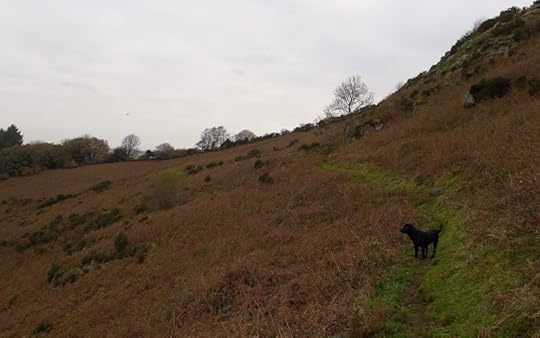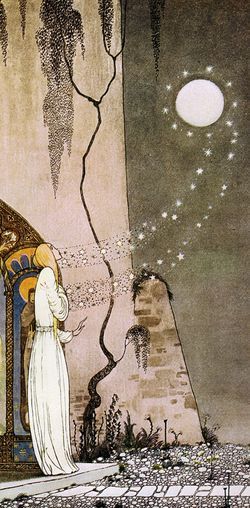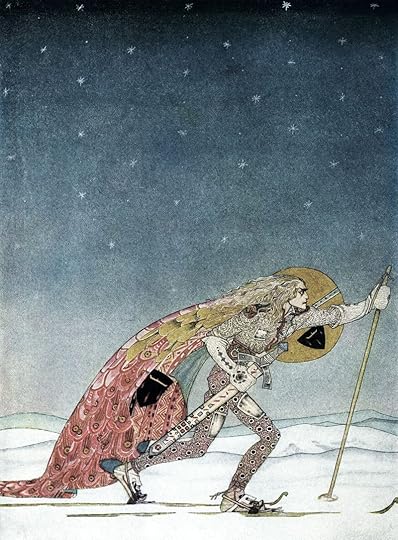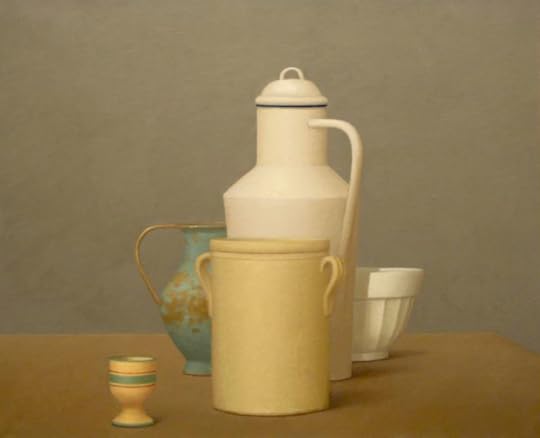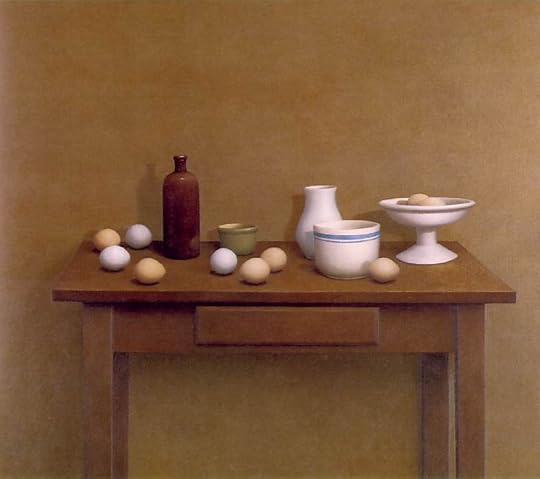Terri Windling's Blog, page 173
January 9, 2014
Embracing the bear
I've long used the term "embracing the bear" for those moments when I'm moving forward into something I fear, but don't want fear to stop me; thus I was intrigued to encounter the same phrase in Terry Tempest William's An Unspoken Hunger, where it has a slightly different, but related, meaning. In a gorgeous little essay on women and bears, Williams includes a description of Marian Engle 's Bear, a highly unsual, memorable novel which portrays a woman and a bear "in an erotics of place":
"It doesn't matter whether the bear is seen as male or female," says Williams. "The relationship between the two is sensual,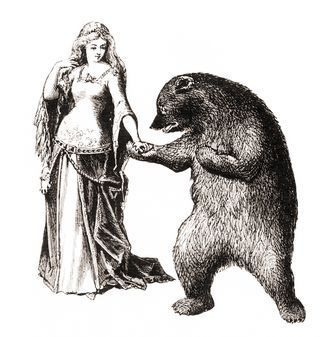 wild.
wild.
"The woman says, 'Bear, take me to the bottom of the ocean with you, Bear, swim with me, Bear, put your arms around me, enclose me, swim, down, down, down, with me.'
" 'Bear,' she says suddenly, 'come dance with me.'
"They make love. Afterwards, 'She felt pain, but it was a dear sweet pain that belonged not to mental suffering, but to the earth.'
William writes that she, too, "has felt the pain that arises from a recognition of beauty, pain we hold when we remember what we are connected to and the delicacy of our relations. It is this tenderness born out of connection to place that 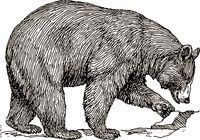 fuels my writing. Writing becomes an act of compassion toward life, the life we often refuse to see because if we look too closely or feel too deeply, there may be no end to our suffering. But words empower us, move us beyond our suffering, and set us free. This is the sorcery of literature. We are healed by our stories.
fuels my writing. Writing becomes an act of compassion toward life, the life we often refuse to see because if we look too closely or feel too deeply, there may be no end to our suffering. But words empower us, move us beyond our suffering, and set us free. This is the sorcery of literature. We are healed by our stories.
"By undressing, exposing, and embracing the bear, we undress, expose, and embrace our authentic selves. Stripped free from society's oughts and shoulds, we emerge as emancipated beings. The bear is free to roam."
"We are creatures of paradox, women and bears, two animals that are enormously unpredictable, hence our mystery," Williams continues. "Perhaps the fear of bears and the fear of women lies in our refusal to be tamed, the impulses we arouse and the forces we represent....As women connected to the earth, we are nurturing and we are fierce, we are wicked and we are sublime. The full range is ours. We hold the moon in our bellies and fire in our hearts. We bleed. We give milk. We are the mothers of first words. These words grow. They are our children. They are our stories and our poems."
The sublime images above are by the Russian surrealist photographer Katerina Plotnikova, based in Moscow. The pen-and-ink drawings are Victorian illustrations, artists unknown.
Other recommended bear fiction, in addition to Bear by Marion Engle: The Red Garden by Alice Hoffman (the woman-bear relationship in this book completely slays me), Her Frozen Wild by Kim Antieau, "Bear's Bride" by Johanna Sinisalo (in The Beastly Bride), "The Brown Bear of Norway" by Isobel Cole (in Black Thorn White Rose), Tender Morsals by Margo Lanagan, East by Edith Pattou, Snow White and Rose Red by Patricia C. Wrede, and Ice by Sarah Beth Durst. There's also a magical story tucked into the stanzas of Theodora Goss's poem, "The Bear's Daughter," and a very beautiful children's book by Jackie Morris, The Ice Bear. Others?
January 8, 2014
Following the bear
While writing yesterday's post, which touched on the value of retreat and hibernation, I was reminded of something Terry Tempest Williams once said about the symbology of bears, and I searched through her interviews (published in A Voice in the Wilderness) until I found the right passage. For Williams, the bear embodies "opposing views, that we can be both fierce and compassionate at once. The bear is above ground in spring and summer and below ground, hibernating, in fall and winter -- and she emerges with young by her side. I think that's a wonderful model for us, particularly as women. And it's one I've tried to adopt."
She goes on to explain that she divides her years into halves. From April Fool's Day to The Day of the Dead (November 1st), she lives a public life as a writer and activist, doing any traveling or public speaking or teaching during these months. From The Day of the Dead until April Fool's Day, however, she stays at home -- to spend time with her family; to write; to live within the rhythms of her creativity. The bear, she suggests, "offers us a model of how one lives with that paradox, of public and private life, of a creative life as well as a life of obligation."
Williams also addresses this theme in An Unspoken Hunger, pointing out that the she-bear has two sides her nature: both fierce and maternal, wild and nurturing. In mythic terms, this oppositional duality held in instinctive balance is the point.
"If we choose to follow the bear," she writes, "we will be saved from a distracted and domesticated life. The bear becomes our mentor. We must journey out, so that we might journey in. The bear mother enters the earth before snowfall and dreams herself through winter, emerging with young by her side. She not only survives the barren months, she gives birth. She is the caretake of the unseen world. As a writer and a woman with obligations to both family and community, I have tried to adopt this ritual of balancing public and private life. We are at home in the deserts and mountains, as well as in our dens. Above ground in the abundance of spring and summer, I am available. Below ground in the deepening of autumn and winter, I am not. I need hibernation in order to create."
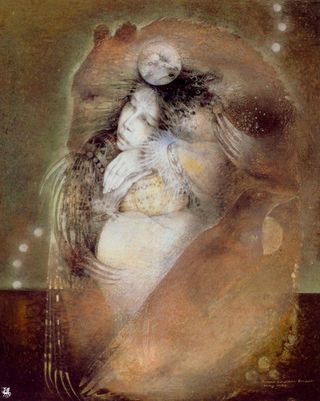 In Women Who Run With the Wolves, psychologist and storyteller Clarissa Pinkola Estés notes the age-old connection of women and bears in the mythic traditions of many different lands. "To the ancients," she writes, "bears symbolized resurrection. The creature goes to sleep for a long time, its heartbeat decreases to almost nothing. The male often impregnates the female right before hibernation, but miraculously, egg and sperm do not unite right away. They float separately in her uterine broth until much later. Near the end of hibernation, the egg and sperm unite and cell division begins, so that the cubs will be born in the spring when the mother is awakening, just in time to care for and teach her new offspring. Not only by reason of awakening from hibernation as though from death, but much more so because the she-bear awakens with new young, this creature is a profound metaphor for our lives, for return and increase coming from something that seemed deadened.
In Women Who Run With the Wolves, psychologist and storyteller Clarissa Pinkola Estés notes the age-old connection of women and bears in the mythic traditions of many different lands. "To the ancients," she writes, "bears symbolized resurrection. The creature goes to sleep for a long time, its heartbeat decreases to almost nothing. The male often impregnates the female right before hibernation, but miraculously, egg and sperm do not unite right away. They float separately in her uterine broth until much later. Near the end of hibernation, the egg and sperm unite and cell division begins, so that the cubs will be born in the spring when the mother is awakening, just in time to care for and teach her new offspring. Not only by reason of awakening from hibernation as though from death, but much more so because the she-bear awakens with new young, this creature is a profound metaphor for our lives, for return and increase coming from something that seemed deadened.
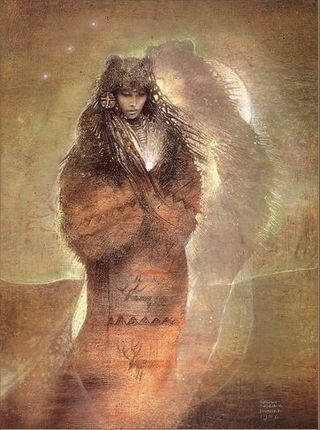 "The bear is associated with many huntress Goddesses: Artemis and Diana in Greece and Rome, and Muerte and Hecoteptl, mud women deities in the Latina cultures. These Goddesses bestowed upon women the power of tracking, knowing, 'digging out' the psychic aspects of all things. To the Japanese the bear is the symbol of loyalty, wisdom, and strength. In northern Japan where the Ainu tribe lives, the bear is one who can talk to God directly and bring messages back for humans. The cresent moon bear is considered a sacred being, one who was given the white mark on his throat by the Buddhist Goddess Kwan-Yin, whose emblem is the crescent moon. Kwan-Yin is the Goddess of Deep Compassion and the bear is her emissary.
"The bear is associated with many huntress Goddesses: Artemis and Diana in Greece and Rome, and Muerte and Hecoteptl, mud women deities in the Latina cultures. These Goddesses bestowed upon women the power of tracking, knowing, 'digging out' the psychic aspects of all things. To the Japanese the bear is the symbol of loyalty, wisdom, and strength. In northern Japan where the Ainu tribe lives, the bear is one who can talk to God directly and bring messages back for humans. The cresent moon bear is considered a sacred being, one who was given the white mark on his throat by the Buddhist Goddess Kwan-Yin, whose emblem is the crescent moon. Kwan-Yin is the Goddess of Deep Compassion and the bear is her emissary.
"In the psyche, the bear can be understood as the ability to regulate one's life, especially one's feeling life. Bearish power is the ability to move in cycles, be fully alert, or quiet down into a hibernative sleep that renews one's energy for the next cycle. The bear image teaches that it is possible to maintain a kind of pressure gauge for one's emotional life, and most especially that one can be fierce and generous at the same time. One can be reticent and valuable. One can protect one's territory, make one's boundaries clear, shake the sky if need be, yet be available, accessible, engendering all the same."
Though Williams and Estés are focused on women and women's issues in the passages above, the oppositional nature of bear symbology is useful to all artists, men and women alike, who struggle to balance their public and private selves, and the often-conflicting demands of family life, community engagement, and creative work. To be available to others, while protecting time to be available only to ourselves and our muse...is this not the dilemma that all creative artists (if we're not complete monsters of self-importance or self-effacement) face again and again?
Commenting on my New Year's Wish in Tuesday's post, Christina Bryant wrote: "I welcome your inclusion of balance between creation and calm this new year. So much focus is put on the doing, I'm glad to see a wish for the restoration and introspection that is vital to the creation process."
Christina is right. As a culture, we tend to prize action, accomplishment, and public expression over stillness, retreat, and quiet reflection...whereas I know for myself that life works best when all of these things are in harmony. What I strive for is hózhǫ́ (as the Navajo express it): a balance between them. A state of sacred symmetry, beauty, and grace.
I've always loved sunshine and warmth (the hotter the better), so the winter months are a challenge for me...and for many years I avoided the cold altogether by wintering in the Arizona desert. But living full-time on Dartmoor now, I have learned to appreciate winter's stark gifts: it slows me down, turns my thoughts inward, keeps me closer to hearth and home, strengthening the introverted side of my nature, without which I couldn't write or paint. I am learning at last to follow the bear; to trust in the process of hibernation and gestation. I am learning patience. Slowness. Stillness.
All things have their season. And spring always comes.
Art above: "The White Bear" and "The Ice Bear" by Jackie Morris, "Hibernation" and "Bear Woman" by Susan Seddon Boulet (1941-1997), a row of bear sculptures by Gene Tobey (1945-2006), "The White Bear King" by Theodor Kittlesen (1857-1914), and some bear cubs from one of my sketchbooks. Photograph: a brown bear and her cubs.
January 7, 2014
The magic of beginnings
I know people who find the ritual of New Year depressing, but I have a great affection for those moments in time that allow us to push the "re-set" buttons in our minds and make a fresh start: the start of a new year, the start of a new week, the start of a new morning or fresh endeavor. As L. M. Montgomery (author of Anne of Green Gables) once wrote, "“Isn't it nice to think that tomorrow is a new day with no mistakes in it yet?”
"Every man should be born again on the first day of January. Start with a fresh page," advised the American theologian and abolitionist Henry Ward Beecher. Some people, of course, find a blank page terrifying...but that's a feeling I've never quite understood. I love the feeling of potential inherent in an untouched notebook, a fresh white canvas, even a new computer folder waiting to be filled. It's the same sense of freedom to be found at the start of a journey, when all lies ahead and limits haven't yet been reached.
Fear of failure, of course, can dim the pleasure of new beginnings and cause creative paralysis at this crucial time. When such anxieties arise, I remember this useful advice from Helen Keller's mentor, Anne Sullivan: "Keep on beginning and failing," she said. "Each time you fail, start all over again, and you will grow stronger until you have accomplished a purpose -- not the one you began with perhaps, but one you’ll be glad to remember."
All beginnings, of course, are proceeded by endings, and as artists we must comfortable with both sides of the equation. “We must be willing to get rid of the life we've planned," said mythologist Joseph Campbell, "so as to have the life that is waiting for us. The old skin has to be shed before the new one can come. ”
Winter solstice is now passed. The days are growing longer. Like bears in their dens and seeds in the ground, this deep, dark time of year enables our growth and renewal in the months ahead; and I've come to see this slow, thoughtful season of hibernation as something precious, rich, and necessary.
The calendar turns, and a new year has begun."It's time to start something new," said Meister Eckhart, "and trust the magic of beginnings.”
January 5, 2014
Tunes for a Monday Morning
Here's music to kick off a brand new year in the beautiful British countryside: two songs from Johnny Flynn's terrific new album, Country Mile.
Above, a video made for the album's title song. Below, a simple but lovely performance of "Einstein's Idea."
Flynn was born in South Africa, raised in Hampshire, UK, and is now based in London -- where he divides his time between theatre and music. As an actor, he's performed Shakespeare at The Globe, The Apollo Theatre, and other venues, and was nominated for the Olivier Award for his role in Jerusalem. As a singer/songwriter, he's released four good CDs with his backing band, The Sussex Wit. To learn more about Flynn, go here.
Below, "The Water" (from Been Listening), performed at a folk festival in Lewes this past summer. That's Flynn's sister Lillie singing harmony, and Marcus Mumford joining in.
Alas, it's a perfect song for south-west England now, where we're having terrible flooding and water is much on our minds....
 Rain filling the streams to bursting on our hill -- making for a green but soggy winter.
Rain filling the streams to bursting on our hill -- making for a green but soggy winter.
December 24, 2013
Happy winter holidays, everyone! Tilly and I will be ba...
December 22, 2013
Tunes for a Monday Morning
This week, four tunes for the winter holidays....
Above: a traditional English carol, "The Seven Rejoices of Mary," sung by the great Canadian musician and music scholar Loreena McKennitt. In this video, McKennitt is recording the song's vocal track for her 2008 album, A Midwinter Night's Dream.
Below, an enchanting version of another traditional English carol, "The Holly and the Ivy." It's sung by Kate Rusby, from South Yorkshire, on her 2008 album, Sweet Bells.
Next, my favorite holiday song:
"The Christians and the Pagans," by the American singer/songwriter Dar Williams.
And last:
"Winter Trees," beautifully performed by The Staves, a trio of sisters from Hertfordshire.
December 20, 2013
On the cusp of winter solstice...
Lines for Winter
Tell yourself
as it gets cold and gray falls from the air
that you will go on
 walking, hearing
walking, hearing
the same tune no matter where
you find yourself—
inside the dome of dark
or under the cracking white
of the moon's gaze in a valley of snow.
Tonight as it gets cold
tell yourself
what you know which is nothing
but the tune your bones play
as you keep going. And you will be able
for once to lie down under the small fire
of winter stars.
And if it happens that you cannot
go on or turn back
and you find yourself
where you will be at the end,
tell yourself
in that final flowing of cold through your limbs
that you love what you are.
- Mark Strand (from Selected Poems)
 With thanks to Ellen Kushner for introducting me to this poem. I love Strand's work, but this one was new to me. The illustrations above, of course, are by the great Arthur Rackham.
With thanks to Ellen Kushner for introducting me to this poem. I love Strand's work, but this one was new to me. The illustrations above, of course, are by the great Arthur Rackham.
December 19, 2013
After the dark...
The imagination of the Earth,
That knew early the patience
To harness the mind of time,
Waited for the seas to warm,
Ready to welcome the emergence
Of things dreaming of voyaging
Among the stillness of land.
And how light knew to nurse
The growth until the face of the Earth
Brightened beneath a vision of color...
Let us ask forgiveness of the Earth
For all our sins against her:
For our violence and poisonings
Of her beauty.
Let us remember within us
The ancient clay,
Holding the memory of seasons,
The passion of the wind,
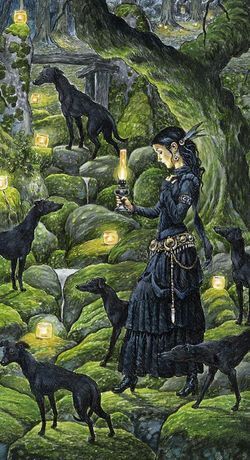 The fluency of water,
The fluency of water,
The warmth of fire,
The quiver-touch of the sun
And shadowed sureness of the moon.
That we may awaken,
To live to the full
The dream of the Earth
Who chose us to emerge
And incarnate its hidden night
In mind, spirit, and light.
- John O'Donohue (from "Let Us Praise this Earth")
"It could be said that this is a hellish moment on earth environmentally, but I don't choose to see it that way. We are defintely disconnected. We know the litany of horrors: the degredation of resources, the level of consumption...I could go on and on. My grandfather would always say, 'I'm as low as a snake's belly.' So what do we do to pick ourselves up from the realities of the world we live in? I believe it is through art we can find our lifeline." - Terry Tempest Williams (from A Voice in the Wilderness)
And so do I.
 With thanks to Michelle, who provided the title for this post in her comment yesterday. The first and last paintings above are by Carl Larsson (Swedish, 853-1919), illustrated the annual Saint Lucia day celebrations in his family. The second painting is a detail from "Out Popped the Moon" by Kay Nielsen (Danish, 1886-1957), and the third is a detail from "Marianna and the Whippets" by my friend and village neighbor David Wyatt.
With thanks to Michelle, who provided the title for this post in her comment yesterday. The first and last paintings above are by Carl Larsson (Swedish, 853-1919), illustrated the annual Saint Lucia day celebrations in his family. The second painting is a detail from "Out Popped the Moon" by Kay Nielsen (Danish, 1886-1957), and the third is a detail from "Marianna and the Whippets" by my friend and village neighbor David Wyatt.
December 17, 2013
Trusting the gift, trusting the way
I have to trust what was given to me
if I am to trust anything
it led the stars over the shadowless mountain
what does it remember in its night and silence
what does it not hope knowing itself no child of time
what did it not begin what will it not end
I have to hold it up in my hands
as my ribs hold up my heart
again in the mountain I have to turn
to the morning
I must be led by what was given to me
as streams are lead by it
and braiding flight of birds
the gropings of veins the learning of plants
the thankful days
breath by breath
- W.S. Merwin (from "Gift")
"If you could do it, I suppose, it would be a good idea to live your life in a straight line -- starting, say, in the Dark Wood of Error, and proceeding by 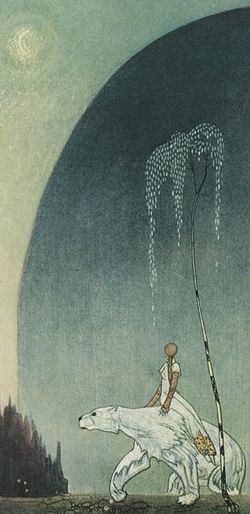 logical steps through Hell and Purgatory and into Heaven. Or you could take the King's Highway past the appropriately named dangers, toils, and snares, and finally cross the River of Death and enter the Celestial City. But that is not the way I have done it, so far. I am a pilgrim, but my pilgrimage has been wandering and unmarked. Often what has looked like a straight line to me has been a circling or a doubling back. I have been in the Dark Wood of Error any number of times. I have known something of Hell, Purgatory, and Heaven, but not always in that order. The names of many snares and dangers have been made known to me, but I have seen them only in looking back. Often I have not known where I was going until I was already there. I have had my share of desires and goals, but my life has come to me or I have gone to it mainly by way of mistakes and surprises. Often I have received better than I deserved. Often my fairest hopes have rested on bad mistakes. I am an ignorant pilgrim, crossing a dark valley. And yet for a long time, looking back, I have been unable to shake off the feeling that I have been led -- make of that what you will."
logical steps through Hell and Purgatory and into Heaven. Or you could take the King's Highway past the appropriately named dangers, toils, and snares, and finally cross the River of Death and enter the Celestial City. But that is not the way I have done it, so far. I am a pilgrim, but my pilgrimage has been wandering and unmarked. Often what has looked like a straight line to me has been a circling or a doubling back. I have been in the Dark Wood of Error any number of times. I have known something of Hell, Purgatory, and Heaven, but not always in that order. The names of many snares and dangers have been made known to me, but I have seen them only in looking back. Often I have not known where I was going until I was already there. I have had my share of desires and goals, but my life has come to me or I have gone to it mainly by way of mistakes and surprises. Often I have received better than I deserved. Often my fairest hopes have rested on bad mistakes. I am an ignorant pilgrim, crossing a dark valley. And yet for a long time, looking back, I have been unable to shake off the feeling that I have been led -- make of that what you will."
- Wendell Berry (Jayber Crow)
"What does it mean to stand inside darkness? What does it mean to allow yourself to travel through Hell? You don't see anything for a good long while, but then your eyes adjust and different senses take over. It is a shot through the dark. Have the courage to stay with it, to stay in it. It has its own beauty. I was raised that the goal is to be happy. I don't believe that. I think the question is not 'how do we be happy?' but 'how to we embrace change?' To me, part of that transformation takes place in the dark." - Terry Tempest Williams (A Voice in the Wilderness)
 The paintings above are by Danish illustrator Kay Nielsen (1886-1957). To see more of his work, and to learn more about his remarkable life, go here. The last piece is a textile design by the English illustrator Walter Crane (1845-1915).
The paintings above are by Danish illustrator Kay Nielsen (1886-1957). To see more of his work, and to learn more about his remarkable life, go here. The last piece is a textile design by the English illustrator Walter Crane (1845-1915).
December 16, 2013
Gracious acceptance
The other side of the coin from "the art of giving" (which we were discussing here last week) is, of course, the "art of receiving" -- and to live a balanced, creatively fecund life we must learn to practice both with equal skill. But as Alexander McCall Smith points out (in his novel Love Over Scotland), gracious acceptance is "an art which most never bother to cultivate. We think that we have to learn how to give, but we forget about accepting things, which can be much harder than giving."
"Until we can receive with an open heart," notes psychologist Brené Brown astutely, "we're never really giving with an open heart. When we attach judgment to receiving help, we knowingly or unknowingly attach judgment to giving help."
Elizabeth Gilbert, in her acclaimed TED Talk on nurturing creativity, describes how, to the early Romans, an artist's "genius" was a spirit or daemon believed to be attached to that particular artist, and not a personal attribute. The divine spark of inspiration came from the daemon; the artist's job was to be a worthy vessel, to recognize the gift, and to use it well. Lewis Hyde echoes and expands on this idea throughout the text of his brilliant (and daemon aided?) book, The Gift: "Part of the work cannot be made, it must be received; and we cannot have this gift except, perhaps, by supplication, by courting, by creating within ourselves that 'begging bowl' to which the gift is drawn."
"Human life runs its course in the metamorphosis between receiving and giving," the German Romantic poet Johann Wolfgang von Goethe once wrote; and art-making, too, thrives in the space where giving and receiving dance in partnership. We take in the gifts of inspiration, shape them to our purposes, and then pass those gifts along through our stories, paintings, and other creative works.
To be skilled in the art of "gracious acceptance" is be wide-open and receptive to the gifts the muses bring, and this skill, it seems to me, is helped or hindered by one's perception of the act of gratitude. There are those for whom gratitude is an uncomfortable, weakening, even shameful feeling; while others of us experience gratitude as a warm, joyful emotion -- forging bright chords of connection, not heavy chains of obligation.
The narrator of Elizabeth Berg's novel Open House is clearly in the latter camp: "I made cranberry sauce," she tells us, "and when it was done put it into a dark blue bowl for the beautiful contrast. I was thinking, doing this, about the old ways of gratitude: Indians thanking the deer they'd slain, grace before supper, kneeling before bed. I was thinking that gratitude is too much absent in our lives now, and we need it back, even if it only takes the form of acknowledging the blue of a bowl against the red of cranberries."
Mary Oliver, too, is a writer who seems to follow Meister Erkhart's dictum that "if the only prayer you ever say in your entire life is thank you, it will be enough" -- for every poem she writes is a hymn of gratitude for the commonplace marvels of daily living. Take her 1992 poem "The Kitchen," for example:
Salt shining behind its glass cylinder.
Milk in a blue bowl. The yellow linoleum.
The cat stretching her black body from the pillow.
The way she makes her curvaceous response to the small, kind gesture.
Then laps the bowl clean.
Then wants to go out into the world
where she leaps lightly and for no apparent reason across the lawn,
then sits, perfectly still, in the grass.
I watch her a little while, thinking:
what more could I do with wild words?
I stand in the cold kitchen, bowing down to her.
I stand in the cold kitchen, everything wonderful around me.
"The reality of all life is interdependence," notes cultural anthropologist Mary Catherine Bateson. "We need to compose our lives in such a way that we both give and receive, learning to do both with grace, seeing both as parts of a single pattern rather than as antithetical alternatives."
"For so many centuries, the exchange of gifts has held us together," adds Barry Lopez (in his luminous memoir, About This Life). "It has made it possible to bridge the abyss where language struggles."
Art-making, like gift giving, requires two separate actions: giving and receiving, both of them equally important. We breathe in the world and push it out again: inhaling, exhaling; the cycle kept in motion; never resting for too long on one side and not the other. The perpetual giver, like the perpetual receiver, is an artist (and a person) out of balance, in danger of draining the creative well dry. It's hard work, and it's humbling work, to master both roles equally, including whichever one we find the hardest -- but that's precisely the task that art (and life) demands of us.
"When we give cheerfully and accept gratefully," says Maya Angelou, "everyone is blessed.”
The quietly beautiful still life paintings above are by the American artist William Bailey. Bailey was born in Iowa in 1930, educated at the University of Kansas, and is now Professor Emeritus of Art at Yale University.
Terri Windling's Blog
- Terri Windling's profile
- 708 followers

















